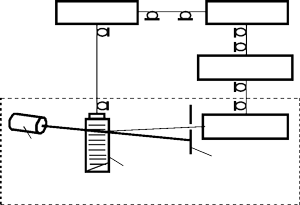Approximation method for investigating acousto-optic delay line characteristics
DOI:
https://doi.org/10.3103/S0735272721110042Keywords:
approximation method, acousto-optic delay line, photoelastic interaction, diffraction, Bragg diffraction, laser, elastic wave, acousto-optic modulator, pass-band dispersion delay line, photoelectronic multiplier, optical beamAbstract
This paper has displayed high potential capabilities of the acousto-optic delay line (AODL) in processing the wideband analog signals. The actuality of the development of the theory of physical processes in AODL suitable for practical applications is substantiated. An approximating method for solving this problem is proposed. It was shown that the use of piecewise-linear approximation made the calculation of the time and frequency characteristics of AODL much easier. Universal formulas were derived for determining the AODL output response, its duration and the rise time at different ratios of the input pulse duration and the time of the elastic wave packet crossing the laser beam. The method and formulas are proposed for determining the AODL cutoff frequency. The numerical simulation of the proposed formulas was performed and their adequacy proved. The paper discusses the possible use of obtained formulas for investigating the AODL characteristics beyond the cutoff frequency. The established patterns and the numerical analysis results were experimentally approbated using the mockup of AODL with direct detection. The oscillograms of input and output pulses obtained at different ratios of the input pulse duration to the time of the elastic wave packet crossing the laser beam are discussed in the context of established patterns and the numerical analysis results. The cutoff frequency was determined by using the normalized experimental graph plot of AODL amplitude frequency characteristic, and it was shown that the obtained cutoff frequency was in good correspondence with the numerical analysis results.
References
S. N. Mantsevich, E. I. Kostyleva, “Examination of the temperature influence on phase matching frequency in tunable acousto-optic filters,” Ultrasonics, vol. 91, pp. 45–51, 2019, doi: https://doi.org/10.1016/j.ultras.2018.07.016.
Z. He, C. Li, R. Xu, G. Lv, L. Yuan, J. Wang, “Spectrometers based on acousto-optic tunable filters for in-situ lunar surface measurement,” J. Appl. Remote Sens., vol. 13, no. 02, p. 1, 2019, doi: https://doi.org/10.1117/1.JRS.13.027502.
A. A. Orlov, O. D. Moskaletz, D. O. Moskaletz, “Correlation measurements in the optical range,” in Optics and Photonics for Information Processing IX, 2015, vol. 9598, p. 95980Y, doi: https://doi.org/10.1117/12.2187797.
O. V. Shakin, V. G. Nefedov, P. A. Churkin, “Aplication of acoustooptics in electronic devices,” in 2018 Wave Electronics and its Application in Information and Telecommunication Systems (WECONF), 2018, pp. 1–4, doi: https://doi.org/10.1109/WECONF.2018.8604351.
K. B. Yushkov, V. Y. Molchanov, A. V. Ovchinnikov, O. V. Chefonov, “Acousto-optic replication of ultrashort laser pulses,” Phys. Rev. A, vol. 96, no. 443866, 2017, doi: https://doi.org/10.1103/PhysRevA.96.043866.
O. Schubert, M. Eisele, V. Crozatier, N. Forget, D. Kaplan, R. Huber, “Rapid-scan acousto-optical delay line with 34 kHz scan rate and 15 as precision,” Opt. Lett., vol. 38, no. 15, p. 2907, 2013, doi: https://doi.org/10.1364/OL.38.002907.
J. Chandezon, J.-M. Rampnoux, S. Dilhaire, B. Audoin, Y. Guillet, “In-line femtosecond common-path interferometer in reflection mode,” Opt. Express, vol. 23, no. 21, p. 27011, 2015, doi: https://doi.org/10.1364/OE.23.027011.
M. Okoń-Fąfara, A. Kawalec, A. Witczak, “Radar air picture simulator for military radars,” in XII Conference on Reconnaissance and Electronic Warfare Systems, 2019, vol. 11055, p. 52, doi: https://doi.org/10.1117/12.2525032.
A. R. Diewald, M. Steins, S. Müller, “Radar target simulator with complex-valued delay line modeling based on standard radar components,” Adv. Radio Sci., vol. 16, pp. 203–213, 2018, doi: https://doi.org/10.5194/ars-16-203-2018.
A. R. Gasanov, R. A. Gasanov, R. A. Akhmedov, “Analysis of amplitude-frequency response of acousto-optic delay line,” Radioelectron. Commun. Syst., vol. 64, no. 1, pp. 36–44, 2021, doi: https://doi.org/10.3103/S0735272721010040.
H. Li, Q. Liu, M. Li, “GHz integrated acousto-optics,” in 2016 International Conference on Optical MEMS and Nanophotonics (OMN), 2016, pp. 1–2, doi: https://doi.org/10.1109/OMN.2016.7565815.
A. R. Gasanov, R. A. Gasanov, “Electronic-controlled acousto-optic delay lines (AODL) discrete steps,” Instruments Syst. Monit. Control. Diagnostics, no. 9, pp. 6–10, 2015, uri: https://www.elibrary.ru/item.asp?id=24237942.
A. R. Gasanov, R. A. Gasanov, “Investigation of response of acousto-optic delay line to short impulse,” Instruments Syst. Monit. Control. Diagnostics, no. 3, pp. 54–56, 2018, doi: https://doi.org/10.7868/S0032816218030114.


